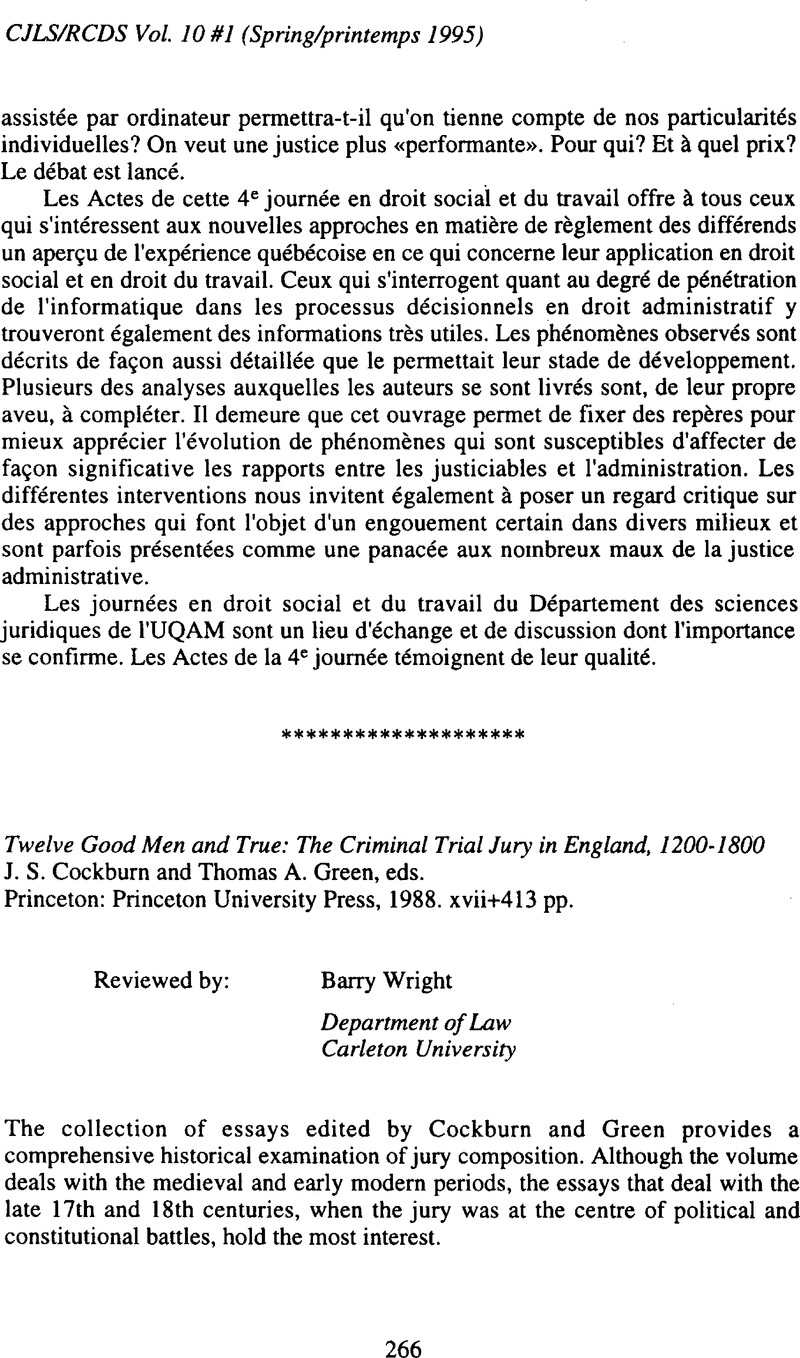No CrossRef data available.
Article contents
Twelve Good Men and True: The Criminal Trial Jury in England, 1200-1800J. S. Cockburn and Thomas A. Green, eds. Princeton: Princeton University Press, 1988. xvii+413 pp.
Published online by Cambridge University Press: 18 July 2014
Abstract

- Type
- Reviews/Recensions
- Information
- Canadian Journal of Law and Society / La Revue Canadienne Droit et Société , Volume 10 , Issue 1 , Spring/printemps 1995 , pp. 266 - 271
- Copyright
- Copyright © Canadian Law and Society Association 1995
References
1. See Linebaugh, P., “Marxist Social History and (Conservative) Legal History: A Reply to Professor Langbein” (1985) 60 New York University La. Rev. 212Google Scholar; Langbein, J., “Albion's Fatal Flaws” (1983) 98 Past and Present 96CrossRefGoogle Scholar.
2. Hay, D. et al. , eds., Albion's Fatal Tree: Crime and Society in Eighteenth Century England (1975)Google Scholar; Thompson, E. P., Whigs and Hunters: The Origins of the Black Act (1976)Google Scholar; Linebaugh, P., The London Hanged: Crime and Civil Society in the Eighteenth Century (Cambridge: Cambridge University Press, 1992)Google Scholar.
3. Reid has examined the broader implications of the jury in 18th century America and Ireland, and Romney its role in early 19th century Canada. Both suggest that civil juries were also at the centre of political controversy. See Reid, J. P., In a Defiant Stance: The Conditions of Law in Massachusetts Bay, The Irish Comparison, and the Coming of the American Revolution (Penn.State University Press, 1977)Google Scholar; Romney, P., “From Constitutionalism to Legalism: Trial by Jury, Responsible Government and the Rule of Law in Canadian Political Culture” (1989) Law and History Review 121Google Scholar.
4. McLane, Post, and, in particular, Powell point out that the degree to which the jury was self-informing is not entirely clear; jurors often did not reside in the immediate vicinity and evidence presented in court tended to be more thorough than what has generally been thought to be the case.
5. There are various social dimensions to the jury explored in the essays covering this early period. Groot also emphasizes how the jury was an attempt to reduce violence between members of society, and Powell and McLane explain high acquittal rates to the social shame surrounding indictment and the uses of trial by an accused for vindication. Powell's reference to rape cases and charges against clergy who violated celibacy vows are interesting in this respect.
6. As Beattie puts it at p. 252: “It seems reasonable to think that these men with broad experience of the criminal courts and of all level of government in the City may well have played an important part in the encouragement of changes that were beginning to transform the criminal law and criminal administration in this period.”
7. Legislation passed in 1692 mandated that jurors be in possession of lands worth 10 pounds and required each county to keep a list of eligible persons. Using these lists, Hay calculates that only 16% to 18% of adult urban males were eligible, and an even lower percentage for grand juries.
8. Hay completely vindicates his position with a devastating dismantling of John Langbein's polemical attack on the work of social historians in “Albion's Fatal Flaws”, supra note 1. See, especially, Hay's note 17, supra note 2 at 310. It is noted that Langbein's critique of Hay's analysis of property qualifications in an earlier work rests on an Elizabethan reference and an equally irrelevant eulogy to the moral probity of modern American jurors (see note 134 at 351–52). Hay also attacks Langbein's assumption that there was a moral consensus across all social classes regarding theft (note 147 at 356). More generally, Hay defends himself against Langbein's erroneous attribution of a crude conspiracy thesis to him, concluding that: “Langbein's misunderstanding of my entire account of the criminal law is fairly complete, and the empirical evidence in his article is misleading on many other matters besides jury qualifications and their effects” (note 147 at 356).




